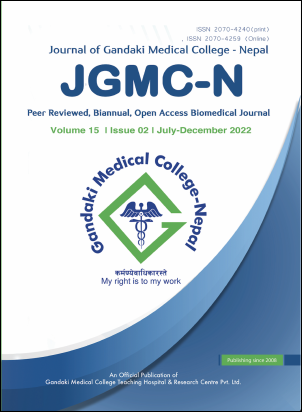Assessment of root and root canal morphology of mandibular premolars using cone beam computed tomography in a tertiary center of Nepal
DOI:
https://doi.org/10.3126/jgmcn.v15i2.48971Keywords:
Cone beam computed tomography, mandibular premolars, Nepalese population, root canal morphology, Vertucci’s root canal configurationAbstract
Introduction: Mandibular premolars are considered an enigma in dentistry because of their variability in anatomical and morphological features making it difficult to treat endodontically. This study was conducted to determine the root and canal morphology of mandibular premolars in the Nepalese population by using cone beam computed tomography imaging.
Methods: One hundred and thirty-four cone beam computed tomography images of the Nepalese population were collected by convenience sampling method from April 1 to August 31, 2022 in Bir Hospital, Kathmandu, Nepal. A total of 536 premolars (268 mandibular first premolars and 268 mandibular second premolars) were evaluated by two examiners (one endodontist and one oral radiologist). Canal configuration was classified according to Vertucci’s classification.
Results: In mandibular premolar teeth, the majority had one root followed by two roots and fused roots. The most common configuration in mandibular premolars was Vertucci’s type I (83.88% and 96.65% in the first and second premolar respectively) followed by type V (9.89%) in the first premolar and type III (1.86%) in the second premolar. Vertucci’s type VII (0.37%), C-shaped configuration (1.46%), and an unusual configuration (0.37%) were observed in the first premolar. In mandibular first premolars, males showed more variation than females; while in second premolars, females showed more variation than males.
Conclusions: Mandibular premolar teeth showed variation in root and canal morphology with one root and Vertucci’s type I in the majority of the cases.
Downloads
Downloads
Published
How to Cite
Issue
Section
License
Copyright (c) 2022 Shikha Bantawa, Deepa Niraula, Sirjana Dahal, Reema Joshi, Asha Thapa, Reetu Shrestha, Santosh Kumari Agrawal

This work is licensed under a Creative Commons Attribution-NonCommercial 4.0 International License.
This license allows reusers to distribute, remix, adapt, and build upon the material in any medium or format for noncommercial purposes only, and only so long as attribution is given to the creator.

